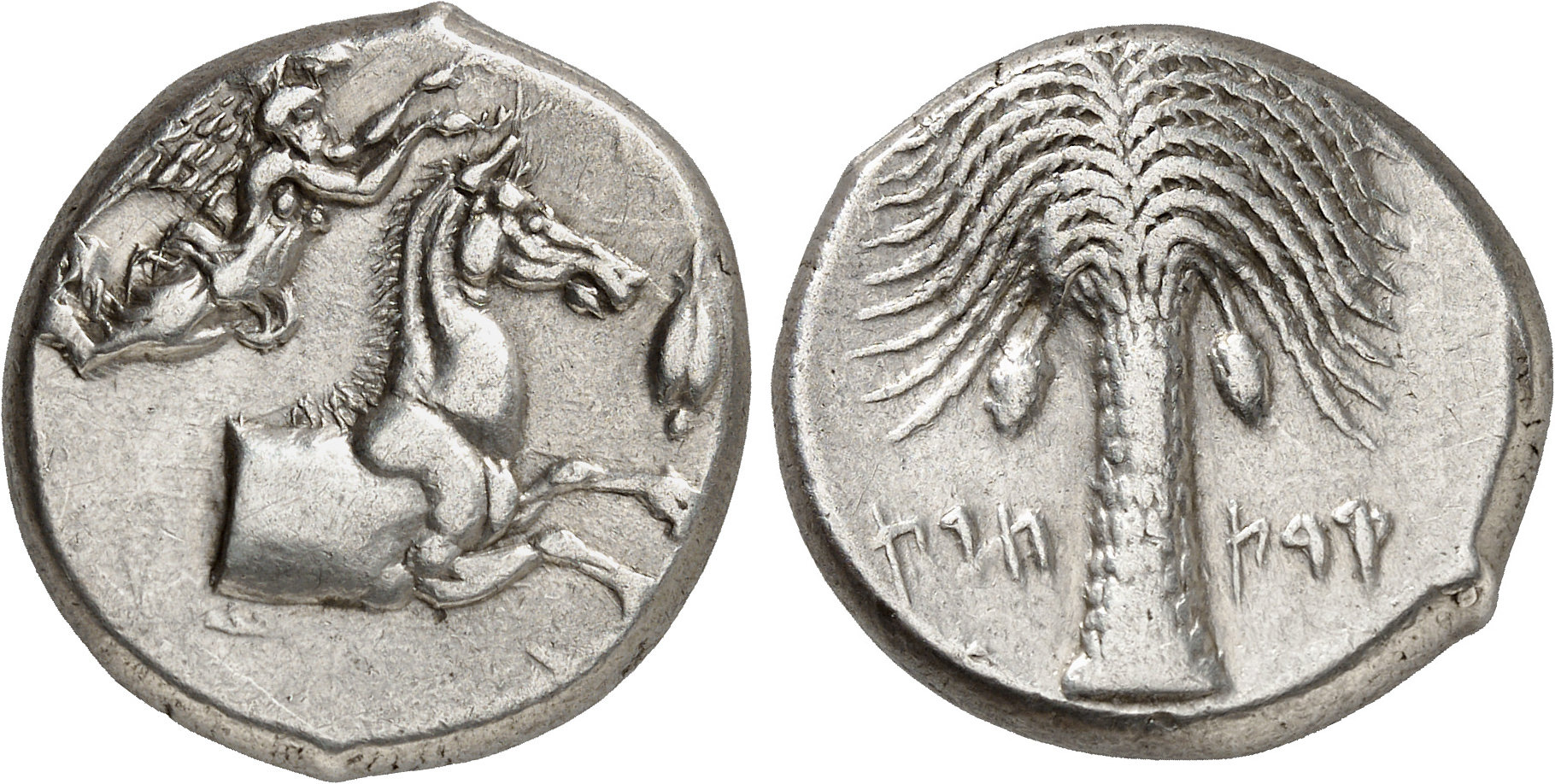Siculo-Punic (uncertain mint), silver, tetradrachms (407-398 BCE)
From SILVER
407 BCE - 398 BCE Silver 4,097 kg
Description
| ObverseInscription or printing placed on the obverse.: | Forepart of horse advancing right, above, Nike flying right, crowning horse with open wreath held in both hands, barley grain to right |
| ReverseInscription or printing placed on the reverse.: | QRT ḤDŠT ("Carthage" in Punic) (Punic).Palm tree with two date clusters |
Mint and issuing power
| MintIdentifies the place of manufacture or issue of a numismatic object.: | Siculo-Punic (uncertain mint) | Ancient regionAncient region.: | Sicily | Modern countryModern country: Italy | AuthorityIdentifies the issuing power. The authority can be "pretended" when the name or the portrait of X is on the coin but he/she was not the issuing power. It can also be "uncertain" when there is no mention of X on the coin but he/she was the issuing power according to the historical sources: | Carthaginian Empire |
Chronology
| FromIdentifies the initial date in a range assigned in a numismatic context. | 407 BCE | toIdentifies the final date in a range assigned in a numismatic context.. | 398 BCE | PeriodTime period of the numismatic object.: Classical 480-323 BC |
Physical description
| MetalThe physical material (usually metal) from which an object is made.: | Silver |
Median weightMedian of the weights of numismatic objects (in grams). in grams | 17.00 | DenominationTerm indicating the value of a numismatic object. Examples: tetradrachm, chalkous, denarius.: | tetradrachm |
StandardStandard.: |
Image

S 1518 - Entella (Carthage), silver, tetradrachms (407-398 BCE).jpg [1]
References
| Die study referencePublication of the study: | Jenkins 19741Jenkins 1974 | ||
| Coin series referenceReference to coin series study: | HGC 22HGC 2, n° 258 | ||
Obverse dies distribution
| FrequencyFrequency of specimen in distribution. ᵖ | Number of obversesNumber of obverse dies. ᵖ (o) | % (o) | Number of coinsNumber of coins. (n) | % (n) | Die nameName(s) of the die(s). |
| 1 | 1 | 8.33 | 1 | 0.72 | 2 |
| 2 | 1 | 8.33 | 2 | 1.44 | 9 |
| 3 | 2 | 16.67 | 6 | 4.32 | 5, 11 |
| 4 | 1 | 8.33 | 4 | 2.88 | 1 |
| 8 | 1 | 8.33 | 8 | 5.76 | 10 |
| 9 | 2 | 16.67 | 18 | 12.95 | 4, 9 |
| 15 | 1 | 8.33 | 15 | 10.79 | 6 |
| 17 | 1 | 8.33 | 17 | 12.23 | 8 |
| 26 | 1 | 8.33 | 26 | 18.71 | 12 |
| 42 | 1 | 8.33 | 42 | 30.22 | 3 |
| Total | 12 of 12 | 99.98 | 139 of 139 | 100.02 |
Reverse dies distribution
no distribution is available
Quantification
| Number of obversesNumber of obverse dies. ᵖ (o) | 12 | Number of singletons (o1)The number of singleton coins. ᵖ | 1 |
| Number of reverse diesNumber of reverse dies. (r) | 42 | Number of coinsNumber of coins. (n) | 139 |
| Coins per obverse dieNumber of coins per obverse die. (n/o) | 11.58 | Coins per reverse dieNumber of coins per reverse die. (n/r) | 3.31 |
| Reverse per obverse ratioRatio of obverse dies divided by reverse dies. (r/o) | 3.5 | Percentage of singletons (o1)number of coins (n) divided by the number of singletons (o1) ᵖ | 8.33 % |
| Original number of dies (O) (Carter 1983 formula)The estimation of the number of coins according to Carter 1983 ᵖ | 12.05 | Coins struck if 20,000 as average productivity per dieCoins made if the average productivity for obverses (according to Carter) is 20,000. ᵖ | 241,000 |
| Original number of dies (O) (Esty 2011 formula)The estimation of the number of coins according to the singleton formula in Esty 2011 ᵖ (O) | 13.13 | Survival rate if 20,000 as average productivity per dieSurvival rate if average productivity is 20,000. ᵖ | 0.00058 |
| Coverage (o = % of O) (Esty 1984 formula)Esty 1984 - coverage (% of O) ᵖ (o = % of O) | 99.28% | Die productivity if survival rate 1/2,000Average productivity if survival rate is 1/2,000. ᵖ | 23,070.54 |
| Weight of silver (in kg) if 20,000 coins per die (O = Carter formula)Carter 1983 * Median weight * 20000 (*10 if gold or electrum) ᵖ | 4,097 kg <br /> 4,097 kg | Die productivity if survival rate 1/5,000Average productivity if survival rate is 1/5,000. ᵖ | 57,676.35 |
Remarks
Most likely one single workstation Certainly military